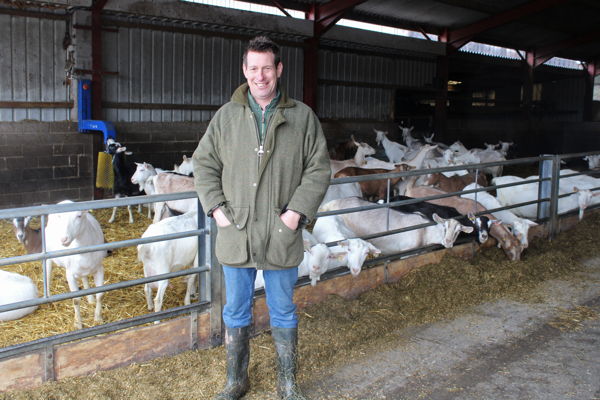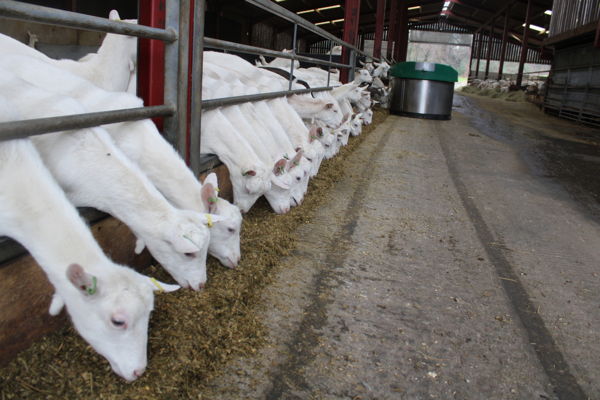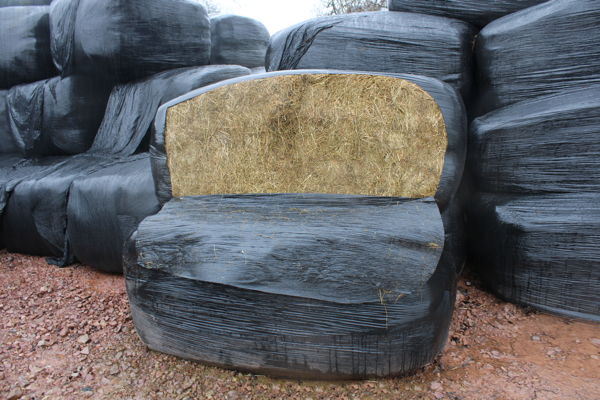2024-04-16 |
The Yeoman’s Farm in Monmouthshire
Attention to detail when producing and utilizing high quality large square bale silage is an essential component in the successful management for Gary and Jess Yeoman’s milking goat herd.
The couple, who both graduated together at Harper Adams University, farm 300 acres close to Abergavenny in Monmouthshire, the gateway to Wales.
In 2002, they made the decision to convert the farm from dry stock to producing milk from goats.
Gary Yeoman
The herd of Saanen and Toggenburg cross goats now totals 1,000 head and are milked twice a day through a 20/40 DeLaval swing milking parlour.
Herd average is now 1,200 Litres per head with butterfat at 4% and protein at 3%.
Using a Keenan mixer wagon they feed a total mixed ration (TMR) consisting of home-grown forages and cereals to make the most of their farmland.
They also keep 20 pedigree Welsh black suckler cows with calves; 20 store cattle; and 38 beef calves and young stock under 24 months.
Gary (see photo) is a former NFU Cymru county chairman and Jess is a previous winner of the NFU Cymru Wales Female Farmer of the Year Award in 2018.
This long established award, seeks to champion the contribution that women make to the Agri industry and to raise the profile of women in farming.
The goat’s milk is converted into cheese locally, which gives the farm a premium price compared to milk from dairy cows.
Their farm is only 5 miles from Abergavenny Creamery, the largest and most successful producer of fresh goat’s cheese in Britain.
They have hosted many customer visits over the years, including many supermarkets, food service wholesalers and fast-food chains such as McDonald’s, Pizza Hut and KFC as well as a visit from the future Prince and Princess of Wales the Duke and Duchess of Cambridge in 2002 to mark St David's Day.
Feed management
When it comes to fodder Gary says, "You need to be very careful with forage quality, storage and management; goats are fussy eaters and are more susceptible
to problems (such as Listeriosis) caused by poor quality forage and they can also suffer from acidosis."
Silage is a big investment so the focus is on making the best possible quality. Gary added, "We like to give a balanced diet and make some haylage to mix in for a healthy diet.
All our forage is baled in large square bales as we find this gives us more flexibility to take crops out at the right stage and at feeding time,
the bales are easy to handle and stay fresh for longer unlike a large silage clamp face."
They produce 800 large square bales taken from three cuts per year, with a mix of perennial rye grass and white clover
as well as Lucerne and forage maize grown on a rotation with a regular reseeding programme.
The Yeoman’s farm has their own mowers, tedders, and rakes as well as a static bale wrapper but use a local contractor to bale the crop.
The bales are brought in for wrapping as the farm has a level free draining hard-core yard; this ensures the bales are not standing in water during heavy rain.
Gary and Jess then stack their bales up to 4 rows high depending on dry matter. The farm's aim for a DM (dry matter) of 35% – 40%.
The Yeomans’ also grow arable crops to feed their livestock.
The young goats are fed with hay and the older ones with haylage and silage.
Gary added, "We like new technology and innovations and are always keen to see the benefits in all aspects of the farm.
We have a robot that follows a magnetic strip in the floor & keeps the silage pushed up to the goats in the feed passage, always keeping fresh fodder within easy reach."
The herd of Saanen and Toggenburg cross goats now totals 1,000 head
Award Winning Baled Silage
In 2021, Gary and Jess Yeoman’s farm won the Big Bale Competition, which is a testament to their silage quality.
Their excellent big bale analysis showed a DM of 36.0%, Crude Protein 17.6%, D-value 70.5, ME of 11.3, and pH of 4.6.
The Royal Welsh Agricultural Society and the Federation of Welsh Grassland Societies run the all-Wales clamp and big bale silage competitions.
Dave Davies, from the Silage Solutions consultancy and technical judge said “These were stand out winners both in terms of silage quality but also the value they were getting from their preserved forages.
They have an impressive goat dairying system with conserved forage at the heart of the system. Ensiling not only grass but also utilizing Lucerne grass mixtures into their silage system.”
"When it comes to bale wrapping, we have always used Silotite®,” says Gary.
High quality silage requires high quality balewrap
"When it comes to bale wrapping, we have always used Silotite®,” said Gary. “It is a quality film that we purchase from the local Wynnstay Agriculture store.
Gary used Silotite original boxed product, which has been market-leading for 40 years, before deciding to make the switch to SilotitePro1800®,
based on a recommendation by the store manager. “We decided to give it a go and were very impressed”.
“SilotitePro1800 is 300 metres longer, which gives us an extra 3 to 4 bales from each reel”, said Gary.
“This is a big benefit for us, as it decreases our downtime and overall reel usage. Having less handling, transportation, and storage is great”.
SilotitePro1800 is supplied in sleeve packaging, which is made from the same PE film as the bale wrap.
The sleeve packaging is ten times lighter than an equivalent cardboard carton. Both the balewrap and packaging can be recycled together where PE film collections exist.
“Eliminating the need for bulky boxes and simplifying recycling is an added convenience for sure.
We have also reduced our packaging waste considerably”, explained Gary.





